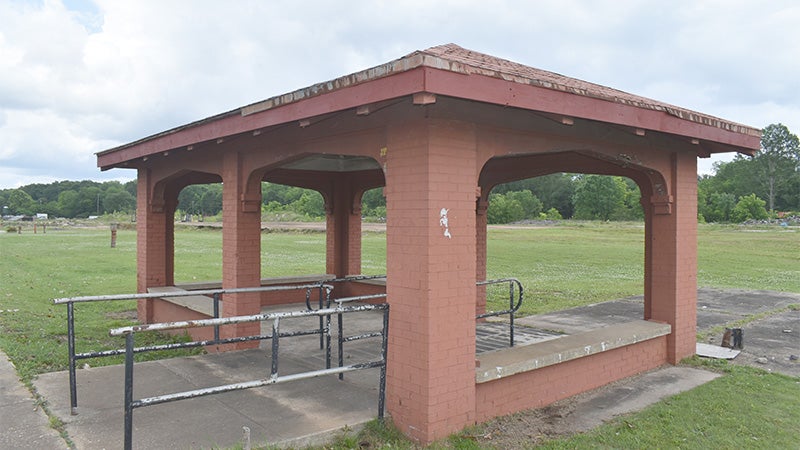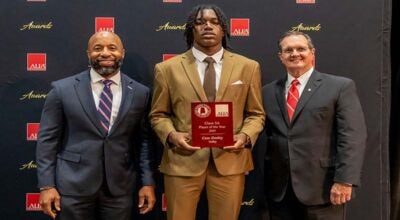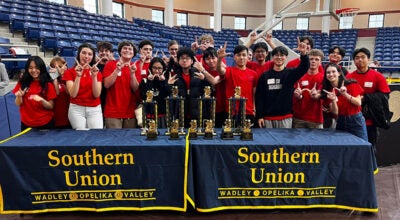CCDA transforms old nickel bus station
Published 9:30 am Saturday, May 20, 2023
|
Getting your Trinity Audio player ready...
|
LANETT — One of the last surviving links to Lanett Mill and the CV Railway has gotten a new lease on life. The old nickel bus station that sits along Highway 29 on the Lanett Mill site has gotten some much needed rehab work. It had been looking pretty shabby in recent times but is now looking as good as new.
When asked about the former train station’s new look, Mayor Jamie Heard credited the Chambers County Development Authority (CCDA) for giving this historic structure the needed improvements. “The Development Authority maintains the mill site,” Mayor Heard said. “I asked (Executive Director) Valerie Gray if something could be done about the old station. She hired a contractor to get it done. We appreciate this. It looks so much better now.”
The station, the mill’s water tower and a guard shack next to Sandy’s Service Center are are that’s left of the once mammoth Lanett Mill/Lanett Bleachery & Dye Works complex.
Before Highway 29 was four laned in the late 1940s, the CV Railway ran in front of the mill. The CV ran from 1895 until 1992, connecting the Valley towns by rail. There were stations up and down the line where people could wait for a train to arrive. The Lanett station offered shelter for people leaving the mill and heading back home. At one time, passenger service was provided by battery-powered electric cars. They could carry up to 50 people, and riders called them nickel buses because that’s how much it cost to ride. One could travel from West Point to River View for five cents in those days.
The Lanett shelter appears in an ironic photograph from 1939. It’s in the background and in the foreground is a car carrying President Franklin Roosevelt on a visit to the Valley on March 30, 1939.
What’s thought to be the largest crowd ever assembled for an event in Valley history took place the day. West Point Manufacturing Company President and CEO George H. Lanier wanted to make a big impression on the president. FDR rode in an open car from one end of the Valley to the other on that day. Seated with him in the back seat was Smith Lanier Sr., who had worked with the president’s administration on some flood control measures to protect West Point. A levee was built on the north side of town to help deflect high water away from the downtown district. This can be seen as the first step in what would lead to the construction of West Point Dam between 1965 and 1975.
Cobb Memorial Archives has an itinerary of the president’s visit to the west central Georgia-east central Alabama region that day. It was on a Thursday and started with him and his entourage boarding a train in Atlanta between 7 a.m. and 7:20. The train headed south and stopped in West Point at approximately 8:30 a.m. before continuing on into Alabama. At Chehaw Station, the president’s party got off the train and had a motorcade to nearby Tuskegee for a visit to the VA hospital and to meet local officials. A widely circulated photo of FDR shaking hands with famed scientist George Washington Carver was taken at the Tuskegee stop. The president spoke to an assembled crowd at Tuskegee Institute. From there, Roosevelt and his party took the drive to Auburn, where he spoke to a crowd of students and faculty at Alabama Polytechnic Institute (now Auburn University). Everyone enjoyed a picnic lunch before the president and those accompanying him went to Opelika, where the president met with a group of school children. Then it was up Highway 29, where the motorcade would cross the Osanippa Creek bridge and enter Fairfax during the one o’clock hour. A new school to be known as Valley High was going up at the time.
This is where West Point Manufacturing Company, local schools and residents of the mill villages had turned out in a big way. Lines of people some three and four rows deep were on both sides of the road all the way through West Point. It was the first time a president of the United States had come to the area, and everyone wanted to make a good impression.
Photos taken that day show that it worked. FDR was in a jovial mood all along the nine-mile ride from Fairfax through West Point. He waved his hat to the crowds and smiled broadly all along the way.
A report in the Chattahoochee Valley Times noted that Col. E.W. Starling, head of the White House Secret Service, and several of his men had been in West Point for several days carefully planning the president’s trip. West Point Police Chief Reed Mobley filled them in on local details.
It was announced at the Wednesday meeting of the West Point Lions Club that all the mills and local schools would be closed during the one o’clock hour so people could turn out to see the president. West Point Mayor W.H. Scott asked all businesses in downtown West Point to be closed at 1 p.m. so people could line the streets as the president’s motorcade came through the city. The president stopped briefly in front of West Point High and at the 10th Street School to speak to students. The motorcade then turned east toward the Little White House in Warm Springs, where FDR spent some of his happiest days.
“It was the thrill of many a person to see the president,” reads the April 6, 1939 edition of The Chambers County News. “That’s something that does not happen to most people in this country and something that may not happen here again for many years to come. It was a day we all felt very proud of.We thank everyone who had anything to do with his coming here. It was a great day for us all.”
Roosevelt (1882-1945) helped the American people regain faith in themselves. He brought hope of a better life for people both black and white, something few, if any, political leaders can do today.
FDR was the only U.S. president who was elected four times. He led the country through the dark days of the Great Depression and through the dark days of World War II, when over 400,000 Americans lost their lives. The day President Roosevelt came to town was a bright spot for local people during an otherwise troubled period.
That little train station in Lanett has stood for more than a century now. If it had eyes, it would have seen a lot in its time, but nothing as memorable as the day President Franklin Roosevelt came to town.
It’s a good thing it hasn’t been torn down.
Chris Busby of the CCDA staff told The Valley Times- News that a recent inspection found the structure to be stable and safe but that some improvements were needed.
The land behind it may be due for some redevelopment. Some inspections have taken place to see if a Brownfields grant is needed. Brownfields cleanups take place on former industrial or commercial sites.
If any contamination is found, it can be cleaned up. If not, it’s ready for redevelopment. In either case, it’s like having a Good Housekeeping Seal of Approval that this is an ideal site for new development.





